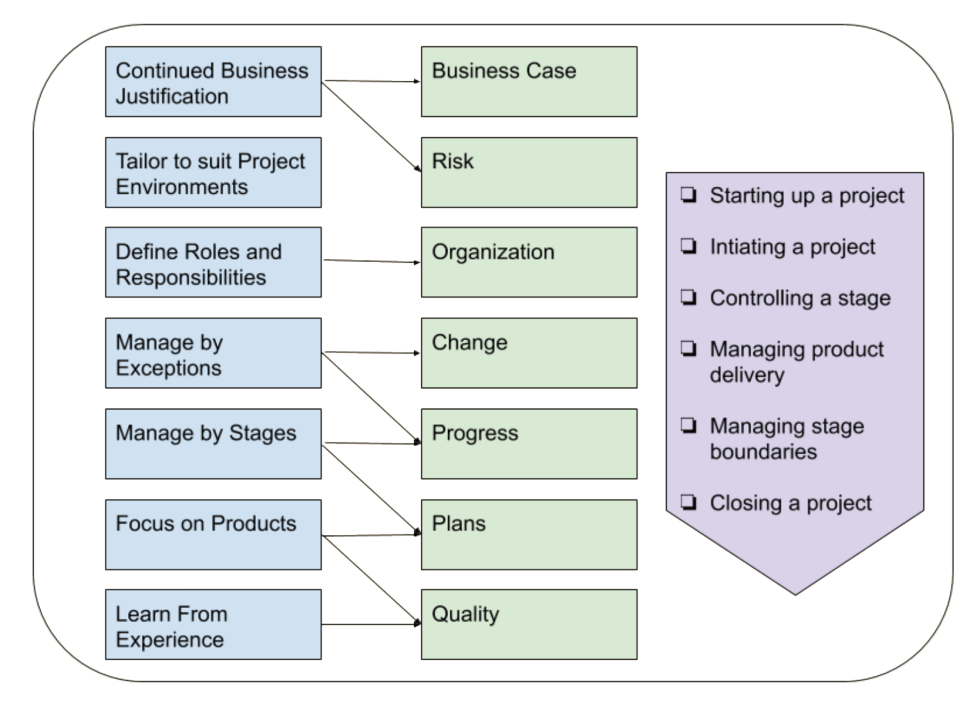Project Management Guide
Project Management Guide
What Is Project Management?
What Is a Project?
Why Is Project Management Important?
Project Life Cycle Phases
- Project Initiation
- Project Planning
- Project Execution
- Project Monitoring
- Project Closure
Project Management Methodologies
- Waterfall Project Management
- Critical Path Method
- Critical Chain Project Management
- Agile Project Management
- Scrum Project Management
- Kanban Project Management
- Lean Project Management
- Six Sigma Project Management
- PRINCE2
- PRiSM
- PMBOK Method
Project Management FAQ
PRINCE2 Project Management
An acronym for (PR)ojects (IN) (C)ontrolled (E)nvironments, PRINCE2 is a structured project management method that emphasizes on dividing a project into manageable phases. Apart from being the primary method used by the UK government, the flexibility that PRINCE2 offers has also made it one of the top project management methods to be used in over 150 countries.
This guide touches upon the seven themes, principles, and processes that PRINCE2 is built upon to help you gain foundational knowledge on what PRINCE2 is and how you can use this approach for your projects.

What Are the Principles of PRINCE2?
PRINCE2 is rooted in seven principles that act as the foundation upon which everything else in the methodology is built. The principles outlined below allow the framework to be applied to a project of any size, type, or scale.
1. Continued Business Justification
You need to have a justifiable reason to be running and managing the project. A comprehensive cost assessment, proper need recognition, a defined target audience, and practical benefits of the project are some elements that can help you identify whether the project is viable or not, at every stage.
2. Learn From Experience
You need to continually seek and record lessons at every step so that you and others can use it to improve future work. Similarly, you should continually strive to learn from the struggles of previous projects.
3. Defined Roles and Responsibilities
A PRINCE2 team has a clear organizational structure where everyone knows what each individual in the group is responsible for.
4. Manage by Stages
A PRINCE2 project is broken up into individual work phases to be managed and controlled on a stage-by-stage basis. Periodic reviews between stages can help you spot if the project is going off-track anywhere.
5. Manage by Exception
A PRINCE2 project has six performance goals established by senior-level managers that the project manager leading the project must fulfill. While senior-level managers don’t take part in the daily overseeing of a project, any deviation from these goals invites their involvement to decide on the next steps.
6. Focus on Products
The quality requirements of the product should be continually checked against the established specifications.
7. Tailor to Suit Project Environment
PRINCE2 is modified to suit the demands of each project, depending on the project’s size, complexity, and risk, among other things.
Bonus: Performance Goals (AKA Aspects)
A permitted deviation from the planned tolerances – the performance goals are quantified parameters that aid the decision-making processes. PRINCE2 has six such aspects:
- Scope
- Timescale
- Risk
- Quality
- Benefits
- Costs
What Are the Themes Involved in PRINCE2 Project Management?
PRINCE2 themes are conceptual approaches based on the principles, which are continually addressed and applied throughout the project. The themes mentioned below empower PRINCE2 practitioners to shape and manage their projects confidently.
1. Business Case
Implements ‘continued business justification’ by creating and maintaining a record of the supporting points.
2. Organization
Defines and establishes a project management team structure to determine who is accountable for what in the project.
3. Quality
Specifies the quality requirements of the product, lays down how they are to be achieved, and verifies if they are fit for purpose in the end or not.
4. Plans
The means of when, how, where, by how much, and to whom the project is to be delivered are defined.
5. Risk
The odds of realizing a successful project are improved by identifying, analyzing, and controlling uncertain outcomes.
6. Change
Any probable and agreed-upon changes to the baseline product are identified, analyzed, and controlled.
7. Progress
The achievements of the project to date are monitored and compared to the planned outcomes to control deviations and provide forecasts.
Read More: Measuring a Project’s Progress, Step by Step
What Are the Processes of PRINCE2?
The processes of the PRINCE2 methodology are where the methodology’s principles and themes are applied. They have been proven in practice to enable a scalable and easily tailored method for managing projects. Here is a quick rundown on all seven of them.
- Starting up a Project
- The project team is appointed.
- The project brief is produced.
- Initiating a Project
- The project initiation plan is finalized.
- The business case is refined.
- Directing a Project
- How the project board will manage the project is determined.
- Controlling a Stage
- The way each individual stage has to be managed is established.
- Managing Product Delivery
- The link between the customer and the supplier is regulated by placing formal requirements on the team manager for accepting, executing, and delivering project work.
- Managing Stage Boundaries
- An updated view of each stage is provided to the project board to dictate how the transition from one step to another is to take place.
- Closing a Project
- A fixed point at which the project is to be considered accepted is confirmed.
- The follow-up actions are determined.
- The benefits that spring from the project are evaluated.
Is PRINCE2 the Project Management Methodology for You?
The PRINCE2 methodology is commended for how widely applicable it is, with the primary points of critique being its failure to offer leadership capabilities and specialist aspects. Whether you choose PRINCE2 for your project or not, needs to be based on their compatibility with each other, gained through a thorough investigation of your project.
